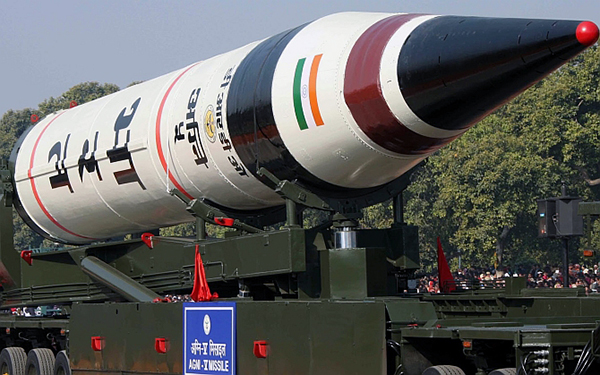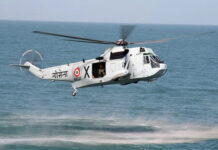Agni-V ICBM and S-400 AD System
Agni-V User Trials
The gravity and sudden upscaling of the threat from China has forced India to rapidly opertionalise its nuclear triad to achieve credible deterrence. A major step was the operationalization of the Agni – V ICBM and its induction into India’s Strategic Forces Command (SFC) after completion of user trials. It was first test fired in Apr 2012 and has now been operationalized.
Agni-V is a three-stage, solid fuel, road-mobile, canister-based missile. As per Dr VK Sarasvat this has a range of 5000- to 5800 kms. The Chinese believe the range of this missile is 8000 km. Thus, this ICBM can cover all major Chinese cities on its east coast as well as its north east, including Beijing, the capital city of China. This can be done from bases in Central and Southern India. From there, it could engage targets in the whole of China, Asia and Europe (this should give Turkey due cause for caution in its interventionist ambitions in Jammu & Kashmir). It has MIRV capability and could carry 2 to 10 independently targetable nuclear war heads. Since it has advanced technology ring-laser gyroscope and accelerometer, its accuracy levels are very high. In addition, it has a back up micro-inertial navigation system (MINGS). Composite materials have been used to reduce weight and enhance the range. It can also serve as an ASAT weapon and take out targets up to 800 kms. Being a road mobile canister-based missile it is difficult to target and destroy it in any pre-emptive strike. It can also be launched from ground-based silos and multiple such silos could be built for deception purposes. The induction of this ICBM is a major boost to India’s nuclear deterrence.
Sea Leg of the Triad
India’s first two nuclear submarines – Arihant and Arighat – are already undergoing user trials. The third is presently under construction and three more are planned. Thus, India’s nuclear Triad is now a reality no adversary can afford to ignore.
S- 400 Triumf Missile System
At long last, the eagerly awaited first batch of the S-400 missile system has been delivered by Russia. This despite the US sanctions threat under CAATSA and strident objections by China. Let us not forget, USA has already imposed these sanctions on China and Turkey. However, imposing them against India will have serious geo-political repercussions for the US desire to balance the power of a rising and aggressive China in Asia and the world. India, therefore, is likely to get a waiver. Russia has proved to be a reliable and time-tested weapons supplier and strategic partner due to the essential congruity of interests. This missile system will be a major game changer and disruptor in South Asia. It will make up to a great extent the serious decline in India’s rapidly declining squadron strength. (However, we still need to rapidly induct some 120 Rafale-class aircraft with 100 km+ range beyond-visual-range, air to air missiles). An examination of the capabilities of this highly versatile missile system provides some very highly lethal offensive capabilities against Pakistan. The S-400 missile system has multi-function surveillance and fire control radars. It can pick up to a 100 targets at ranges out to 600 kms. It can engage up to 40 at a given time with its fire control radars. It can pick up low signature stealth aircraft also. It has a set of four missiles to tackle targets at multiple ranges. Thus, it has missiles with 400 km, 240 km, 120 km and down to 40 km ranges to tackle a whole range of threats concurrently. It can intercept enemy incoming enemy missiles, bombers, AWACS , fighter jets, cruise missiles, helicopters and drones. India is getting five regiments of these. China already has six regiments and during the fracas in Ladakh deployed a regiment of S-400 in Ladakh. China has a serious disadvantage of air bases at very high altitudes in Tibet, which limits the payloads its war planes can carry. The induction of the S-400 had made up for this lack of capability opposite Ladakh. With our own induction of S-400 missile system, India has achieved parity. There is a limit to how many S-400 regiments the Chinese can take out from its east coast and deploy against India. China has to cater for Taiwan, Japan and USA over the Pacific theatres.
A2AD Capabilities
It is, however, against Pakistan that we can employ this missile system in an offensive manner. How? Pakistan has very limited strategic depth. The Triumf system can pick up targets at 600 kms and engage them up to 400 kms range. Thus, India could shoot down every single air craft that takes off from any Pakistani airbase at the very outset of any conflict. We could, therefore, destroy the PAF using this missile system in an offensive manner and gain air superiority at the start of any conflict without crossing Pakistani borders. Pakistan will now have to think twice before engaging in any conflict with india. It could prove to be prohibitively expensive and should compel Pakistan to stop its asymmetric provocations against India. In the S-400 India now has an Anti-Access and Area Denial (A2AD) system of proven lethality.


















